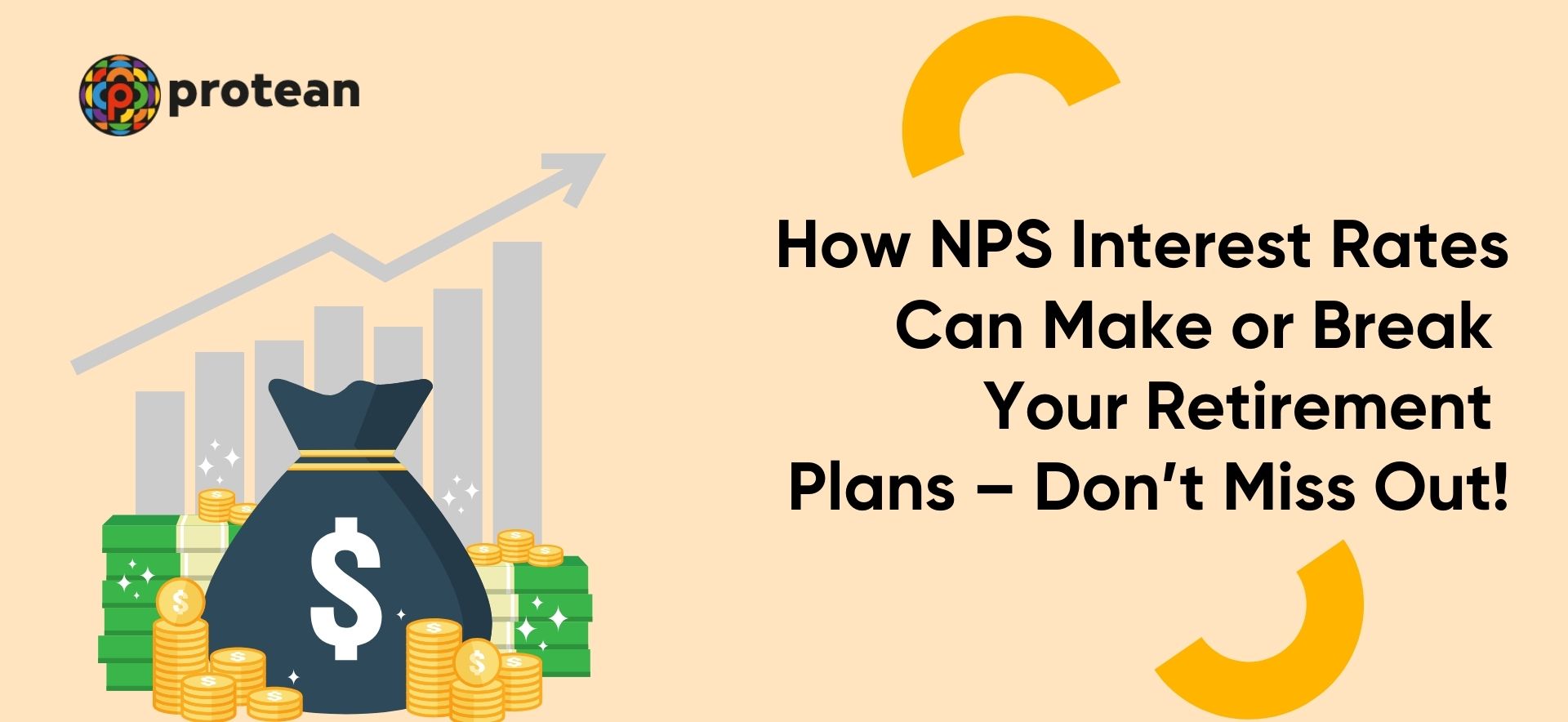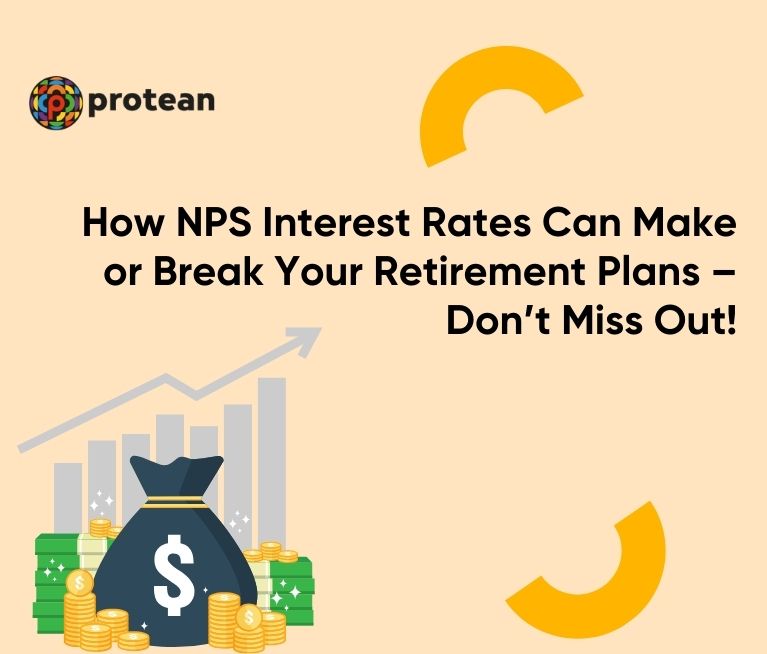The National Pension System offers one of India's most reliable avenues for retirement planning. Its market-linked returns and tax incentives make it an attractive option for those hoping to construct a sound financial future. However, maximising one's retirement funds demands comprehending the intricacies ofthe NPS interest rate and optimising returns.
Minor fluctuations in interest rates can substantially impact ultimate savings. Whether retiring early or aiming for comfort after work, comprehending what affects NPS interest rates is pivotal. Let us investigate what factors impact these rates and how one can stay ahead of the curve.
NPS Interest Rate 2025
Specifying the NPS current interest rate is difficult because it’s not fixed. As the system is market-linked, returns fluctuate based on market conditions. But the NPS interest rate last 10 years has been between 9 to 12%. The NPS's long-term focus, with its power of compounding, aims to generate significant returns over the years, making it a reliable retirement savings tool if invested wisely.
Factors Affecting NPS Interest Rate
NPS returns are determined by multiple economic and financial factors. Here’s a closer look at the key elements influencing NPS interest rates:
1. Market Performance of Equity and Debt Investments
NPS investments are spread across equities, corporate bonds, and government securities, each reacting differently to market conditions. Equity investments offer higher returns but are volatile, while bonds and government securities provide stability with lower returns.
2. Pension Fund Manager (PFM) Performance
NPS investors can choose from multiple pension fund managers (PFMs) who handle investments. The expertise, strategy, and past track record of PFMs play a crucial role in determining returns.
3. Asset Allocation Choices
NPS allows investors to customise their portfolio allocation among asset classes. Higher equity exposure can lead to higher but riskier returns, whereas more debt allocation provides stability.
4. Government Bond Yield Movements
A significant portion of NPS investments is in government securities, whose interest rates fluctuate based on economic policies. If government bond yields fall, NPS returns from debt investments also decline.
5. Global and Domestic Economic Conditions
Recessions, financial crises, or market booms impact stock market returns, affecting the equity component of NPS. International trends, such as the US Federal Reserve's interest rate decisions, also influence Indian markets.
6. Contribution Consistency and Investment Tenure
The longer investors stay in NPS, the more they benefit from compounding. Regular and higher contributions can lead to significant growth in the final corpus. An investor contributing ₹10,000/month for 30 years will accumulate a much larger corpus than someone contributing the same for 15 years.
| Also Read: NPS Calculator for Retirement |
The Impact of NPS Withdrawal Rules on the Interest Rate
The NPS withdrawal rules don't directly impact the interest rates you earn, but they can affect your overall returns. Early partial withdrawals reduce the corpus, which slows down the compounding process and results in lower returns over time. At retirement, the mandatory 40% annuity purchase also reduces the available corpus for lump sum withdrawals, affecting the total amount you can access. While the interest rate itself remains unaffected, how and when you withdraw your funds influences the final maturity amount and pension you receive.
Why Can NPS Interest Rates Make or Break Your Retirement Plans?
The NPS is a pivotal component of retirement planning in India, and its interest rates play a crucial role in determining the growth of your retirement corpus. Understanding the impact of these rates is essential for ensuring financial security in your post-retirement years.
- Impact on Retirement Corpus: The returns generated by NPS investments directly influence the size of your retirement fund. Higher interest rates lead to a larger corpus, providing greater financial comfort during retirement. Conversely, lower rates may result in a smaller fund, potentially affecting your standard of living post-retirement.
- Compounding Effect: NPS investments benefit from the power of compounding, where the returns earned are reinvested to generate additional earnings. Even slight variations in annual interest rates can have a significant cumulative effect over the long term, underscoring the importance of achieving favourable rates consistently.
- Inflation Adjustment: To maintain purchasing power, it's crucial that NPS returns outpace inflation. If the interest rates are not sufficiently high, the real value of your retirement savings could diminish, compromising your financial well-being in later years.
- Investment Strategy: The NPS allows for a mix of equity and debt investments. Understanding how interest rates affect these asset classes can inform your investment strategy, enabling you to balance risk and return effectively to meet your retirement goals.
Strategies to Maximise NPS Returns
Maximising returns from your National Pension System (NPS) investments is crucial for ensuring a comfortable retirement. By implementing strategic approaches, you can enhance the growth potential of your NPS corpus.
1. Choosing the Right Asset Allocation
The National Pension System (NPS) offers various asset allocations that affect the interest rates you earn. These are the primary asset classes:
| Asset Class | Risk Level | Ideal For |
| Equity (E) | High-risk, high-reward | Younger investors seeking growth
|
| Corporate Bonds (C) | Moderate risk | Investors looking for a balance of risk/returns |
Government Bonds (G) | Low-risk, stable returns | Conservative investors prioritising safety |
| Alternative Investment (A) | Limited, diversified risk | Investors seeking diversification |
2. Selecting the Best Pension Fund Manager (PFM)
The performance of your NPS investments is significantly influenced by the Pension Fund Manager (PFM) you choose. Different PFMs have varying investment strategies and track records, which can lead to differences in returns.
Selecting a PFM with a strong performance history can enhance your investment growth. It's advisable to review PFMs' performance periodically and make changes if necessary to align with your investment goals.
Take a look at the top-performing equity pension fund managers for Tier-1 accounts:
| Pension Fund Managers | 1- Year Returns (%) | 3- Year Returns (%) | 5- Year Returns (%) |
| NPS SBI Interest Rate | 30.03% | 15.64% | 19.10% |
| HDFC NPS Interest Rate | 33.10% | 16.10% | 21.15% |
| ICICI NPS Interest Rate | 34.38% | 17.19% | 20.92% |
| LIC Pension Fund | 31.29% | 16.34% | 19.91% |
| Aditya Birla Pension Fund | 32.70% | 16.46% | 20.09% |
| Kotak Mahindra Pension Fund | 33.62% | 17.37% | 20.94% |
Source: NPS Trust
Take a look at the top-performing equity pension fund managers for Tier-2 accounts:
| Pension Fund Managers | 1-Year Returns (%) | 3-Year Returns (%) | 5-Year Returns (%) |
| NPS SBI Interest Rate | 30.18% | 15.84% | 19.24% |
| HDFC NPS Interest Rate | 33.14% | 16.15% | 20.50% |
| ICICI NPS Interest Rate | 33.14% | 17.04% | 20.88% |
| Kotak Mahindra Pension Fund | 33.57% | 17.39% | 20.74% |
| LIC Pension Fund | 30.41% | 16.02% | 19.89% |
| Aditya Birla Pension Fund | 33.42% | 16.86% | 20.14% |
Source: NPS Trust
3. Regularly Reviewing Your NPS Portfolio
Regular portfolio review is essential to ensure that your asset allocation remains aligned with your financial objectives and risk tolerance. Market movements can cause your portfolio to drift from its intended allocation, potentially exposing you to unintended risks.
Annual rebalancing involves adjusting your investments to restore your original asset allocation. For instance, if a surge in equity markets increases the equity proportion of your portfolio beyond your desired level, selling a portion of equities and reallocating to bonds or government securities can help maintain your risk profile.
Adjusting equity exposure based on market trends can also be beneficial. In bullish markets, you might consider realising some gains from equities, while in bearish markets, increasing equity exposure could position your portfolio for future recovery. However, such decisions should be made cautiously, considering your investment horizon and risk tolerance.
4. Making Additional Contributions for Higher Growth
Beyond mandatory contributions, making voluntary additional contributions to your NPS account can significantly enhance your retirement corpus. The power of compounding means that even small additional investments can grow substantially over time.
Consider the following scenario:
| Monthly Contribution | Total Investment Over 30 Years | Estimated Corpus at 8% Annual Return |
| ₹ 5,000 | ₹ 18,00,000 | ₹ 75,40,000 |
| ₹ 10,000 | ₹ 36,00,000 | ₹ 1,50,80,000 |
***This illustration assumes a consistent annual return of 8%. Actual returns may vary based on market conditions.
As demonstrated, doubling your monthly contribution from ₹5,000 to ₹10,000 results in a corpus that is twice as large, highlighting the significant impact of additional contributions. Thus, voluntary contributions can play a crucial role in achieving your retirement goals.
| Also Read: NPS Tax Benefits & Rules |
How to Calculate NPS Interest Rate
NPS returns are influenced by the performance of the underlying market-linked NPS fund, which is then compounded monthly. This makes NPS interest rate calculation a complex process. Instead of manual calculations, it is advisable to use an NPS calculator online. Simply input details such as:
- Your Age
- Monthly Investment
- Expected Rate of Return
- Expected Pension Return
This will estimate the total maturity amount, interest earned, and monthly pension from your NPS contributions.
Example of NPS Interest Calculation
Amit, aged 30, plans to invest in the NPS scheme and retire at 60. His investment details are as follows:
- Monthly Investment: ₹10,000
- Estimated NPS Rate of Interest: 10%
He enters these details into the NPS Calculator. The following results are displayed:
| Investment Details | Amount |
| Total Investment | ₹ 36,00,000 |
| Interest Earned | ₹ 1,63,75,000 |
| Maturity Amount | ₹ 1,99,75,000 |
| Monthly Pension | ₹ 66,950 |
| Minimum 40% Annuity Investment | ₹ 79,90,000 |
Important Note:
According to NPS regulations, at least 40% of the accumulated corpus must be invested in an annuity plan upon retirement. This ensures a steady pension income after the age of 60.
Conclusion
The NPS offers a powerful tool for securing a comfortable retirement, with returns influenced by market performance, asset allocation, and fund management. You can maximise your returns by making informed investment choices, regularly reviewing your portfolio, and using tools like the NPS calculator. With a long-term, balanced approach, the NPS interest rate for govt employees can help you build a solid retirement corpus, ensuring financial independence during your golden years.
FAQs
1. Is NPS better than PPF?
NPS offers higher returns due to its market-linked investments, while PPF provides guaranteed, low-risk returns. NPS may be the better choice if you're looking for higher growth and tax benefits.
2. Is NPS better than FD?
NPS generally offers better long-term returns due to its equity exposure, while FDs provide fixed, guaranteed returns. NPS is ideal for retirement savings, whereas FDs are more suited for conservative, low-risk investors.
3. What is the average NPS return?
The average NPS return typically ranges from 8% to 10% per annum, depending on the chosen asset allocation and market performance. However, as NPS investments are market-linked, returns can fluctuate.
4. Is NPS risk-free?
NPS is not risk-free as it involves exposure to market-linked assets like equity and corporate bonds. However, it offers a safer option with government bonds and can be tailored to your risk tolerance.
5. Is the NPS interest rate fixed or variable?
The NPS interest rate is not fixed; it is variable and depends on the performance of the funds in which the money is invested. This means returns can fluctuate based on market performance.
| Also Read: How NPS Scheme Works |
Written by Bruhadeeswaran R.
Bruhadeeswaran R. is a B2B content expert with 14+ years of experience, specializing in National Pension System (NPS), PAN, DPI, eSignPro, and Central KYC. As Editor and Lead Content Writer at Protean eGov Technologies, he simplifies complex e-governance topics through engaging blogs, reports, and digital content.

